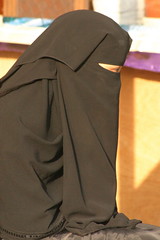The
Kowloon Walled City was something straight out of dystopian fiction - but it was very much factual for the 33,000 people who lived there. Kowloon, as
Wikipedia succinctly puts it, was a "densely populated, largely ungoverned settlement in Kowloon, Hong Kong." In fact, the 6.5-acre

English: Kowloon Walled City, Hong Kong, photographed from an airplane Deutsch: Kowloon Walled City, Hong Kong, Luftbild (Photo credit: Wikipedia)
enclave was the most densely populated space on earth: approximately
1,255,000 inhabitants per square kilometer! For comparison, Wikipedia points out that "Hong Kong as a whole (itself one of the most densely populated areas on earth) had a population density of about 6,700 inhabitants per square kilometer." The settlement dates back to AD 960, but its namesake walls were built by the Chinese in 1847, after the British took control of Hong Kong proper. Following Japan's surrender at the end of World War II, the Chinese reclaimed Kowloon and opened it to refugees; it was then that its population dramatically increased. The Walled City was ultimately cleared and demolished in 1994.
Right now, there's an ongoing "ask me anything" thread at Reddit, posted by Reddit user Crypt0n1te, a former inhabitant of the Walled City. He writes:
I lived in KWC when I was 2-3 years old but I have no recollection of that time. Later on, even though our family moved out of there, but since I was enrolled in the schools near there and my parent worked during the day, so my bro and me were dropped off at my relative's place in KWC everyday. I got to know the place pretty well because I spent at least 4 hrs there everyday from 1984 to 1991. So ask away!







Recent Comments
Alec Defosses :
:
Good read. I saved the page for future visit. read moreShakira Furci :
:
Incredibly interesting piece of content. I was in search of read moreRitts :
:
Your site is amazing. I wonder just how do you read moreMeda Kiner :
:
I found your blog in the "Trackback" section of another read moreGale Mady :
:
The integration of bears into a godly American holiday read moreB. Samuel :
:
This information on how earth worms behave is very fascinating. read more